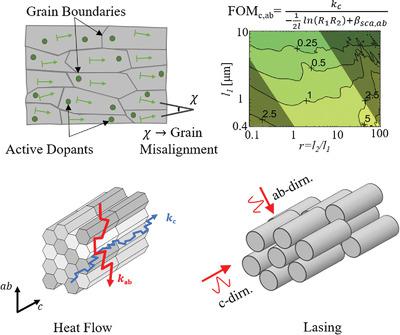当前位置:
X-MOL 学术
›
Adv. Theory Simul.
›
论文详情
Our official English website, www.x-mol.net, welcomes your feedback! (Note: you will need to create a separate account there.)
Leveraging Anisotropy for Coupled Optimization of Thermal Transport and Light Transmission in Micro‐Structured Materials for High‐Power Laser Applications
Advanced Theory and Simulations ( IF 3.3 ) Pub Date : 2020-07-20 , DOI: 10.1002/adts.202000036 Vivek Mishra 1, 2 , Javier E. Garay 3 , Chris Dames 1
Advanced Theory and Simulations ( IF 3.3 ) Pub Date : 2020-07-20 , DOI: 10.1002/adts.202000036 Vivek Mishra 1, 2 , Javier E. Garay 3 , Chris Dames 1
Affiliation

|
Maximum operating power densities in ceramic laser media scale with thermal conductivity k. This requires larger grain sizes in polycrystalline ceramics to reduce phonon scattering at grain boundaries. However, smaller grain sizes are preferred to minimize light scattering in the Rayleigh regime in polycrystals made from birefringent materials such as AlN and Al2O3, which are otherwise appealing for their high k. An optimization challenge arises from the opposite scaling laws governing the effects of grain sizes on k and light transmission. Here, this is tackled by introducing anisotropically microstructured materials (columnar/disk‐shaped grains) as the lasing media, and allowing orthogonal heat transfer and lasing directions. For columnar grains, larger grain sizes along the c‐axis help maintain high k for good heat dissipation, while preserving light transmission properties in the orthogonal lasing and pumping directions. Analytical models for the thermal conductivity in such structures are presented and verified using Monte‐Carlo ray‐tracing simulations. Similarly, an approximate Rayleigh–Gans–Debye model is used to predict light transmission and verified with exact simulations using FEM software. Finally, the tradeoff between thermal and optical phenomena is captured in a new anisotropic figure‐of‐merit tensor, which is optimized for the microstructure that maximizes lasing media performance in AlN and Al2O3 model systems.
中文翻译:

利用各向异性来优化用于大功率激光应用的微结构材料的热传输和光传输的耦合优化
陶瓷激光介质中的最大工作功率密度与导热系数k成比例。这需要多晶陶瓷中较大的晶粒尺寸,以减少声子在晶界处的散射。然而,较小的晶粒尺寸是优选的,以最小化由双折射材料(例如AlN和Al 2 O 3)制成的多晶在瑞利状态下的光散射,否则它们的高k值很有吸引力。控制晶粒尺寸对k的影响的反比例定律带来了优化挑战和透光。在这里,这是通过引入各向异性的微结构材料(柱状/盘状晶粒)作为激光介质并允许正交的热传递和激光方向来解决的。对于柱状晶粒,沿c轴的较大晶粒尺寸有助于保持较高的k在保持良好的散热性的同时,保持正交的激光和泵浦方向的光传输特性。提出并使用蒙特卡洛射线追踪模拟验证了此类结构中的热导率分析模型。同样,一个近似的Rayleigh–Gans–Debye模型用于预测光传输,并使用FEM软件进行了精确的仿真验证。最后,在新的各向异性品质因数张量中捕获了热现象和光学现象之间的折衷,该张量针对微观结构进行了优化,可在AlN和Al 2 O 3模型系统中最大化激光介质的性能。
更新日期:2020-09-23
中文翻译:

利用各向异性来优化用于大功率激光应用的微结构材料的热传输和光传输的耦合优化
陶瓷激光介质中的最大工作功率密度与导热系数k成比例。这需要多晶陶瓷中较大的晶粒尺寸,以减少声子在晶界处的散射。然而,较小的晶粒尺寸是优选的,以最小化由双折射材料(例如AlN和Al 2 O 3)制成的多晶在瑞利状态下的光散射,否则它们的高k值很有吸引力。控制晶粒尺寸对k的影响的反比例定律带来了优化挑战和透光。在这里,这是通过引入各向异性的微结构材料(柱状/盘状晶粒)作为激光介质并允许正交的热传递和激光方向来解决的。对于柱状晶粒,沿c轴的较大晶粒尺寸有助于保持较高的k在保持良好的散热性的同时,保持正交的激光和泵浦方向的光传输特性。提出并使用蒙特卡洛射线追踪模拟验证了此类结构中的热导率分析模型。同样,一个近似的Rayleigh–Gans–Debye模型用于预测光传输,并使用FEM软件进行了精确的仿真验证。最后,在新的各向异性品质因数张量中捕获了热现象和光学现象之间的折衷,该张量针对微观结构进行了优化,可在AlN和Al 2 O 3模型系统中最大化激光介质的性能。



























 京公网安备 11010802027423号
京公网安备 11010802027423号